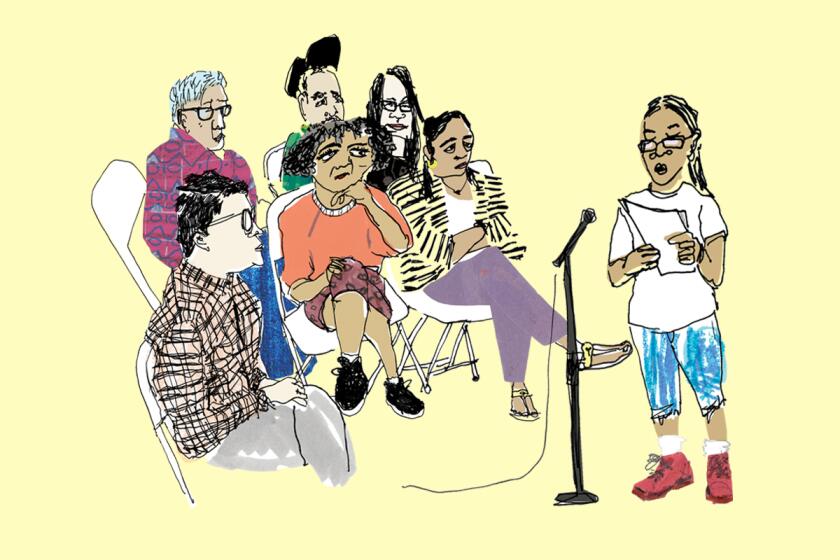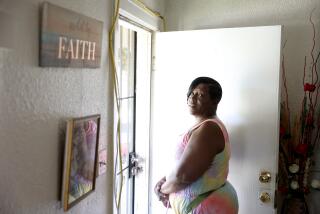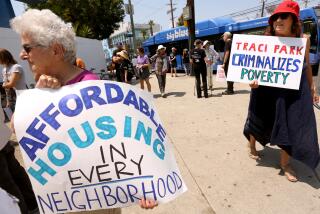L.A. County fails to place older foster kids, leaving them homeless, lawsuit alleges

Los Angeles County is condemning older foster youth to long, destabilizing stints of homelessness and couch-surfing by failing to provide them with appropriate homes, a federal lawsuit filed Tuesday alleges.
In a 108-page complaint, attorneys with four law firms argue that L.A. County, responsible for the local foster care system, and the state of California, which monitors that system, are shirking their legal responsibility to ensure foster youths between the ages of 16 and 21 have a safe and stable place to live. Instead, the filing alleges, local government has created a “foster care to homelessness pipeline.”
In California, eligible youths can opt to remain in foster care until they turn 21. Last year, L.A. County was responsible for more than 4,200 youths between the ages of 16 and 21, according to the lawsuit.
One of the county’s chief responsibilities: ensuring these youth have both stable housing and behavioral health services they will need to tackle long histories of trauma and abuse.
L.A. County continues to place severely troubled young people in hotels. Officials are pressuring the state to open facilities that can accommodate them.
Leecia Welch, a deputy legal director at Children’s Rights, a New York-based child advocacy organization, said the county has failed on both fronts.
“When L.A. makes the decision to take responsibility for raising these young people, and step into the shoes of their parents, at the very least, it can’t leave them homeless,” said Welch, whose firm joined Public Counsel, Munger, Tolles & Olson, and Alliance for Children’s Rights in the lawsuit.
The four firms sued the county’s Children and Family Services and Mental Health departments — which find placements for foster youths and provide them with behavioral health services — as well as the state’s Health and Human Services Agency, Department of Health Care Services and Department of Social Services, all three of which play a role in overseeing and administering these services.
The suit argues both the county and state violated the constitutional rights of older foster youths by subjecting them to “extreme housing instability and homelessness” while they remain in foster care. The suit asks for a judge to require youth be provided with “safe and stable placements at all times.”
The county Departments of Child and Family Services and Mental Health said in a statement that they take the allegations “very seriously” and were aware young people exiting the child welfare system faced “significant stressors,” including lack of housing.
The two county departments “help transition-age youth navigate these and other challenges by providing assistance with education and housing plans, job preparedness, transportation and mental health services,” the statement said. “The county is committed to ensuring the mental well-being of young people as they enter adulthood and providing available services to assist with that transition.”
The three state agencies declined to comment on the ongoing lawsuits.
The suit was filed as a class action on behalf of all county foster youth between the ages of 16 and 21. Six plaintiffs, all given pseudonyms in the filings, say their time in foster care as a teen or young adult has been punctuated with stints of homelessness, violence and instability.
Onyx G, 17, was placed in multiple residential facilities where she experienced harassment and an attempted sexual assault, according to the lawsuit. After being sexually assaulted by a roommate at a different residential program this May, she left the facility and was homeless for three months.
Erykah B., 19, was removed from a foster home “marked by abuse” at age 17 and was put in at least three new homes — in one of which she also experienced an attempted sexual assault, according to the lawsuit. After that, the 19-year-old was briefly homeless, sleeping outside for two weeks with her girlfriend.
Do you know who your L.A. County supervisor is? Do you know how to get her attention? Use Shape Your L.A. to get active in your community.
Rosie S., 20, was offered only referrals to a homeless shelter by the county after a year of couch-surfing, according to the filing. The lawsuits said she is expecting a child, but was told by the county there were no available placements for young parents at the types of transitional housing she was hoping for.
The barriers to housing for foster youth with children of their own are particularly formidable. The filing alleges young mothers and fathers in foster care are regularly barred from placements that would allow them to live with their children or given access to programs with “arbitrary rules” on where children can be fed, forcing parents into “inappropriate and unstable placements in order to live with their children.”
“There is clearly an insufficient number of placements, there’s an insufficient array, and there are also policies and practices that result in instability because young people aren’t getting the support they need,” said Tara Ford, a senior attorney with Public Counsel.
Typically, some older foster youths live mostly independently, finding a home to rent with the county paying a monthly rate, said Rachel Stein with Public Counsel. There are also transitional housing programs for older youths who need more support. She says youths sometimes struggle to access placements through both types of programs.
Youths with serious behavioral health issues have proven particularly difficult for the county to place. The Times reported in May that the county had been placing foster youth in rented hotel rooms. The child welfare agency said at the time the hotels were a last resort as it grappled with a severe shortage of licensed foster homes.
Sarah Manimalethu, director of local advocacy at the Alliance for Children’s Rights, said the county is struggling to place youth partly due to the same housing crisis that has left people across the region priced out of their homes and forced onto the street. The difference between the general homeless population and foster youth, she says, is that the county is legally obligated to get a roof over their head.
“On a gut level, we know housing is a human right, but Congress and the California Legislature have put it into law that housing is a legal right for foster youth,” said Manimalethu. “It’s DCFS’ responsibility to make sure that there’s somewhere for them to go.”
More to Read
Sign up for Essential California
The most important California stories and recommendations in your inbox every morning.
You may occasionally receive promotional content from the Los Angeles Times.












